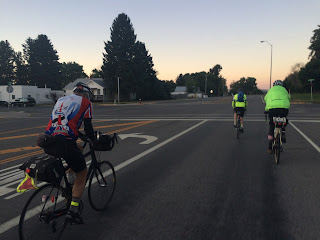Jason Karp, Montana’s RBA, selected a Spanish derivation of
the word ‘Mountain’ (la montaña)
as the brevet ‘Word of the Day’. It
proved to be an accurate representation of what I was to experience for most of the next
17 hours.
Beginning in Bridger, MT on August 1st,
we departed promptly at 6:00 a.m.
Myself, along with four Montanan’s (three of whom were riding their
final brevet prior to Paris-Brest-Paris) left the Bridger Hotel along Main St. and headed
south to Belfry passing fields of wheat, freshly cut hay, and grazed pasture. It was a great way to ease into the ride. The valley of Clark’s Fork afforded us a
comfortable air temperature, and it would be the only time during the day when
we’d enjoy cool conditions at this lower elevation (<4000 feet).
(Rolling out of town)
(Montana wool)
Prior to leaving, the morning couldn’t have been more
stressful. I uncharacteristically
overslept, giving myself less than 30 minutes to prepare and eat breakfast,
change into cycling clothes, and complete a final check of my gear and
bike. I made it in time, but not before
worrying Jason’s wife, Brenda, who knocked on the hotel door at 5:50 a.m.
(“Yes, I’m just about ready… …sorry!”). I rolled out of my room just in time for the
group photo.
[Chief Joseph 300k participants (L to R): Ken, Karel, Ken,
Jason, Mark]
It was an ambitious loop, ascending Bear Creek Hill before passing
through Red Lodge, over Beartooth Pass, into Cooke City (over Coulter Pass),
back over Coulter Pass going east, then southeast over Dead Indian Pass before
turning north on Wyoming Hwy 120 for the last 43 miles. The day would include 14,000+ feet of
climbing, with a maximum elevation just shy of 11,000 feet. Our time limit was 20 hours, meaning we’d
have until 2:00 a.m. Sunday to complete the brevet.
We were fortunate to have nearly perfect riding conditions
over Beartooth Pass, with clear skies, a light breeze, and temperatures ideal
for a hard climbing effort. For me, this
climb (and an all-too-brief descent) was the highlight of the day.
(PBP riders Karel, Ken, and Jason leading the charge up Beartooth Pass)
(Almost to the east summit)
(Brief stop at the west summit)
[Karel adjusts his GoPro for the descent (click here to view)]
(One of many high elevation lakes on the other side of the
pass)
(Motivation to keep pedaling, fast!)
(Onward to Cooke City)
The climb over Coulter Pass proved to be the most difficult
part of the day. With temperatures in
the high 80s, no breeze, and an absence of shade along the road, my pace slowed
considerably. Karel, who had been riding
strong all day, pulled ahead to arrive in Cooke City first. I wasn’t too far behind, joining him at the
Exxon C-Store for lunch (deep-fried hotdogs!) and a well-earned break.
(Main thoroughfare in Cooke City, MT)
I loaded up on water before leaving, realizing there would be
at least 4+ hours of riding in high temperatures before the next
checkpoint. I’m glad I did! It turned out to be a hot afternoon. I backed off my effort accordingly, stopping
periodically to rest and enjoy the wonderful scenery.
(Clark’s Fork of the Yellowstone River)
(Meadows! Trees! Mountains!
Sky!)
(One last crossing over Clark’s Fork before climbing Dead Indian pass)
(After the final climb, an amazing descent on Chief Joseph
Scenic Byway)
The final leg was along Hwy 120, which sloped slightly
downhill nearly all the way back to Bridger.
We lucked out with a moderate tailwind, which allowed for a decent pace into the evening (18-20 mph). The only
challenge was avoiding the rattlesnakes that came out on the road after dusk. I dislike snakes, but they played an
important role in the last 2.5 hours. I
had no problem staying alert. Thanks
snakes!
(Moving quickly north, dodging rattlesnakes along the way)
(One last push of calories and caffeine in front of the
Silvertip Lounge, Belfry, MT)
(Arrived! 17 hours 7
minutes and 194 miles later)
The Chief Joseph 300k was a capstone cycling
experience. For the distance travelled,
I have a hard time imagining a more scenic, exhilarating, and challenging
ride. Jason Karp pushed us hard with
this route, and his wife Brenda provided timely support with food and drink in
the last 40 miles. While I’m in a
definite lull this year with my randonneuring, I am happy having completed this
brevet. For me, the cycling year is
complete.
Kudos to Jason and Brenda for setting the stage for
unforgettable day. They are a great
team. (Jason’s review of the ride can be
found here). I’m also indebted to my
wife, Susan, who had good eats and cold water waiting upon my return.
(Relaxing the next day in Medora, ND)


































